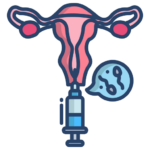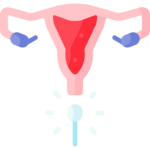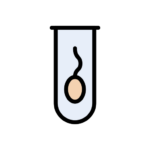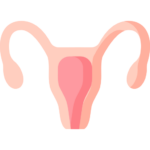Our Services
Infertility Services

Ovulation Induction (OI)
Ovulation induction (OI) means using fertility medications to stimulate the release of one or more eggs from the ovary. OI may be done in one of two particular situations. In some cases, OI is used to help women who have irregular cycles and do not release an egg on their own to ovulate. In other cases, OI is used even if a woman is ovulating regularly on her own. In these cases, the goal is to use the medications at a dose which will allow the release of several eggs – thus increasing the chance of pregnancy

Pre-conception counselling
This a meeting with a health-care professional by a woman before attempting to become pregnant, to reduce the chances of poor obstetric, maternal, and foetal outcomes. It generally includes a pre-conception risk assessment for any potential complications of pregnancy as well as modifications of risk factors, such as increasing folic acid intake to reduce the risk of neural tube defects and counselling on smoking cessation, alcohol reduction, and medications that may compromise foetal development.

Fertility Evaluation
Fertility Evaluation is a preliminary examination done on men and women to check their fertility potential.
A standard fertility evaluation includes physical exams and medical and sexual histories of both partners. Men undergo a semen analysis that evaluates sperm count and sperm movement and structure.For women, doctors first check to see whether ovulation is occurring. This can be determined and monitored through blood tests that detect hormones and ultrasound exams of the ovaries

IUI (Intra uterine insemination)
Intrauterine insemination (IUI) is a procedure that treats infertility. IUI boosts the chances of pregnancy by placing specially prepared sperm directly in the uterus. Another name for the procedure is artificial insemination.
With IUI, the sperm are inserted around the time an ovary releases one or more eggs. The hoped-for outcome is for the sperm and egg to unite in the fallopian tube, which connects the uterus to the ovaries. If this happens, it leads to pregnancy.
Psychological Counseling
Psychological couselling is one of the facets of infertility counselling. It focuses on healing your emotional aspect.
A more holistic approach to patient care is believed to improve health outcomes, increase patient and team satisfaction, reduce negative psychosocial reactions and help patients better come to terms with their experiences.
the counselling, is done to provide your following benefits:
Normalize infertility experience
Improve couple’s relationship
Help you manage your stress
Assist in goal setting decision making
Separating infertility from self esteem
Promote acceptance
Acknowledge the losses
Facilitate grief
Promote responsibility
Plan therapeutic session
This management of psychological factors helps in improving results of infertility couple.
IVF Services

Sperm freezing
It is the process of collecting, freezing and storing sperm. The sperm can be thawed and used in the future for procedures such as intrauterine insemination (IUI) or in vitro fertilization (IVF).

Egg freezing
Egg freezing is a process that involves the hormonal stimulation of the ovaries, followed by transvaginal retrieval and subsequent freezing and storage of a woman’s viable eggs, so she can try and have children at a later date.

Frozen Embryo transfer
A frozen embryo transfer (FET) is a type of IVF treatment in which a cryopreserved embryo created in a previous egg retrieval cycle is thawed and transferred to the uterus. FET is usually preferred when the doctor suspects high risk of OHSS (Ovarian Hyperstimulation Syndrome) in the woman, or when the couple needs PGT (Preimplantation Genetic Testing) of the embryo or when a woman needs other pre-treatments before Embryo transfer.

ICSI
ICSI or Intra Cytoplasmic Sperm Injection is a type of IVF. With traditional IVF, thousands of sperm are placed next to an egg on a laboratory dish. Whether one of the sperm penetrates the egg to fertilize it is left up to chance. If none of the sperm fertilize the egg, conception (also called fertilization) doesn’t occur.
ICSI promotes fertilization through the direct injection of a single sperm into a single egg. Traditional IVF is almost obsolete now.
Embryo Freezing
An embryo is an egg that has been fertilized by a sperm. Embryo freezing, or cryopreservation, is a process that freezes and stores fertilized eggs for later use. It can help people preserve fertility and have options for pregnancy later in life.
Indications:
A successful IVF cycle can result in multiple embryos, and some people choose to freeze the extra embryos for future family building.
Patients who undergo preimplantation genetic testing (PGT) also freeze their embryos after they are tested as it takes over a week to obtain the results.
Freezing embryos is a technique that can also help preserve future fertility. In person who is undergoing hormone therapy, cancer treatment, gender affirmation surgery or another medical intervention that affects their fertility.
In some situations, your physician may recommend freezing your embryos to help avoid the risk of a condition called ovarian hyperstimulation syndrome, which would worsen after pregnancy. It may also be recommended to help increase the chance of pregnancy if certain hormone levels are too high during the IVF cycle.
Male Infertility sevices

Micro TESE (Testicular Sperm Extraction)
Micro TESE is also a procedure that takes sperm directly from the testicular tissue of a man’s reproductive system (testis), similar to TESA, but it uses a different technique to obtain the sperm. This procedure is typically performed by making a few small cuts in the testicle and removing a small amount of tissue.
It is usually performed with the patient under general anesthesia. A single incision is made in the middle of the scrotum. A microscope is used to help see the fine tubules of the testis that may contain sperm. All sutures (stitches) that are used dissolve on their own. The patient is able to go home the day of the procedure, and should be able to resume normal activities within one to two weeks

TESA (Testicular Sperm Aspiration)
Testicular sperm aspiration is a procedure that takes sperm directly from the testicular tissue of a man’s reproductive system, that is – from the testicular tissue in azoospermic patients. It can be used in Obstructive Azoospermia as well as Non obstructive Azoospermia. TESA samples are obtained with a wide-bore needle pushed percutaneously into the testis. To this needle Suction is applied through a syringe to extract testicular tissue.

DFI
The sperm DNA fragmentation index (DFI) reflects the integrity of and the damage to the DNA, the genetic material of the sperm, thereby detecting potential sperm damage. It is an opportunity to evaluate male fertility beyond semen analysis for those undergoing infertility treatments.

Micro Fluidics
Micro fluidics Sperm Sorter technique is a revolutionary technology where highly motile and structurally normal spermatozoa with good DNA integrity are separated from semen so that they can be used in fertility treatments.
Semen Analysis
Semen Analysis is the initial test for evaluation of the male partner. It is an important test which provides the clinician with useful information on the fertility potential of the male partner, but is not an actual test of fertility. The routine semen analysis is an accurate measurement of sperm production and maturation, and the ejaculatory process.
A semen analysis should be performed by an andrology laboratory, which specializes in semen analysis and advanced sperm testing.
Advanced IVF Services

ERA
ERA testing involves an endometrium biopsy followed by gene expression analysis in the endometrial tissue.that determines each woman’s unique personalized embryo transfer timing,therefore synchronizing the embryo transfer with the individualized window of implantation.

PGT
Pre implantation genetic testing (PGT) is a screening test that can be performed on embryos created via in vitro fertilization (IVF) to genetically analyze the embryos prior to transfer.

Blastocyst culture
Blastocyst culture is a laboratory technique used in in vitro fertilization (IVF) where fertilized eggs are grown in a culture dish for up to five days.These extra days will also be helpful for choosing embryos that can grow into blastocysts, which have a greater potential to form pregnancy than early day 3 embryos.

Assisted Hatching
Assisted hatching involves artificial thinning or breaching of the zona pellucida and has been proposed as one technique to improve implantation and pregnancy rates after in vitro fertilization (IVF).

Ovarian and Endometrial PRP and Stem Cell Therapy
Administration of platelet-rich plasma (PRP) , stem cells for the treatment of endometrium- and ovary-associated infertility.rejuvenation therapy is a new and innovative approach to enhancing fertility.
Fertility Preservation

Sperm freezing
It is the process of collecting, freezing and storing sperm. The sperm can be thawed and used in the future for procedures such as intrauterine insemination (IUI) or in vitro fertilization (IVF).

Egg freezing
Egg freezing is a process that involves the hormonal stimulation of the ovaries, followed by transvaginal retrieval and subsequent freezing and storage of a woman’s viable eggs, so she can try and have children at a later date.

Preservation for cancer patients
Freezing embryos ,eggs in females and sperm in male is called cryopreservation, to help preserve fertility in cancer patients.Improvement in cancer management and increasing survival rates has created a need for fertility preservation.
Embryo Freezing
An embryo is an egg that has been fertilized by a sperm. Embryo freezing, or cryopreservation, is a process that freezes and stores fertilized eggs for later use. It can help people preserve fertility and have options for pregnancy later in life.
Indications:
A successful IVF cycle can result in multiple embryos, and some people choose to freeze the extra embryos for future family building.
Patients who undergo preimplantation genetic testing (PGT) also freeze their embryos after they are tested as it takes over a week to obtain the results.
Freezing embryos is a technique that can also help preserve future fertility. In person who is undergoing hormone therapy, cancer treatment, gender affirmation surgery or another medical intervention that affects their fertility.
In some situations, your physician may recommend freezing your embryos to help avoid the risk of a condition called ovarian hyperstimulation syndrome, which would worsen after pregnancy. It may also be recommended to help increase the chance of pregnancy if certain hormone levels are too high during the IVF cycle.
Third party Reproduction

Donor Egg
Donor Egg IVF is an appropriate option for women unable to conceive with their own eggs, provided there is no contraindication to carrying a pregnancy. It is a method of assisted reproduction in which a woman donates her eggs (oocytes) which are used to help another woman to have a baby.

Donor sperm
A sperm donor is a man who donates his sperm so that an infertile individual or couple may use the sperm to achieve pregnancy through IUI or IVF procedure

Surrogacy
Surrogacy means a person agreeing to carry and give birth to a baby for someone else who is unable to carry pregnancy .often supported by a legal agreement, whereby a woman agrees to deliver on behalf of another couple or person, who will become the child’s parent(s) after birth.
Endoscopy

Diagnostic Laparoscopy & Tubal Testing
A diagnostic laparoscopy and tubal test is an operation using keyhole surgery to look at abdominal and pelvic organs, particularly the fallopian tubes. It is used to help find out why a patient is having difficulty becoming pregnant. For some women minor treatments can be performed at the same time.

Hysteroscopy
Hysteroscopy is a procedure that allows a surgeon to look inside of the uterus in order to diagnose and treat any abnormalities of uterus/cervix. Hysteroscopy is done using a hysteroscope, a thin, lighted tube that’s inserted into vagina to examine cervix and the inside of uterus. An operative hysteroscopy can be used to remove polyps, fibroids and adhesions.
Laparoscopy Treatment of - Fibroids / Endometriosis / Ovarian Cysts
Operative Laparoscopic surgery is a minimally invasive surgical technique used in the abdominal and pelvic areas. It is used to remove or treat pre-existing conditions such as Endometriosis,Fibroid Uterus and ovarian cyst. The advantages of this technique over traditional open surgery include
1. A shorter hospital stay and faster recovery time.
2. Less pain and bleeding after the operation.
3. Reduced scarring


